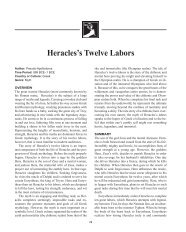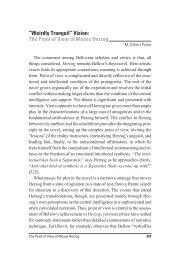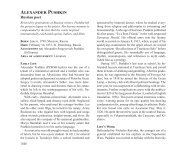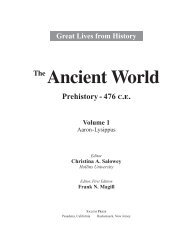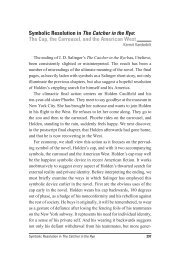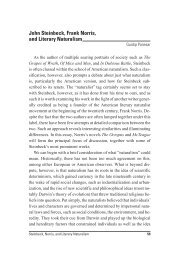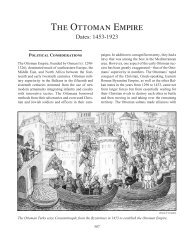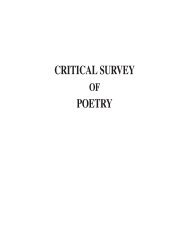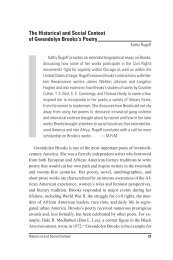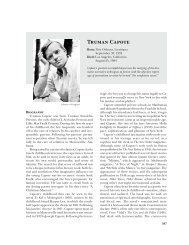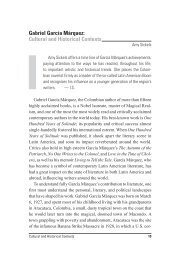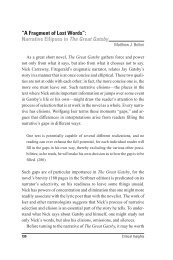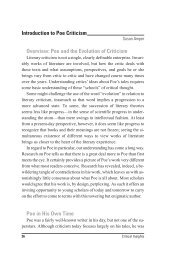Modernity and Anxiety in Bram Stoker's Dracula - Salem Press
Modernity and Anxiety in Bram Stoker's Dracula - Salem Press
Modernity and Anxiety in Bram Stoker's Dracula - Salem Press
You also want an ePaper? Increase the reach of your titles
YUMPU automatically turns print PDFs into web optimized ePapers that Google loves.
<strong>Modernity</strong> <strong>and</strong> <strong>Anxiety</strong> <strong>in</strong><br />
<strong>Bram</strong> Stoker’s <strong>Dracula</strong><br />
Allan Johnson<br />
The immense popularity of <strong>Bram</strong> Stoker’s <strong>Dracula</strong>, susta<strong>in</strong>ed s<strong>in</strong>ce<br />
the novel first appeared <strong>in</strong> 1897 <strong>and</strong> re<strong>in</strong>vigorated by each additional<br />
film, stage, or literary adaptation, is perhaps not an entirely surpris<strong>in</strong>g<br />
phenomenon. <strong>Dracula</strong> is, at its very core, a deeply engag<strong>in</strong>g novel<br />
that is still able to startle <strong>and</strong> concern contemporary readers even at<br />
the distance of more than a century. The impressive status that the text<br />
has earned <strong>in</strong> Anglo-American literary culture as the prime artifact<br />
of the horror genre is at least partially dependent on Stoker’s masterful<br />
storytell<strong>in</strong>g. Yet the sheer enterta<strong>in</strong>ment value of Stoker’s now<strong>in</strong>famous<br />
vampire novel is likely not the only reason that <strong>Dracula</strong> cont<strong>in</strong>ues<br />
to be studied as a central work of British literary fiction <strong>and</strong><br />
rout<strong>in</strong>ely subjected to <strong>in</strong>tense literary criticism that seeks to exam<strong>in</strong>e<br />
the novel’s treatment of mass culture, mental health, Freudian/Jungian<br />
subtextuality, female sexuality, reverse colonization, <strong>and</strong> modernity.<br />
That is, <strong>Dracula</strong> (like the Count himself) possesses deeper secrets<br />
<strong>and</strong> hidden complexities that challenge readers to enter <strong>in</strong>to the dark<br />
<strong>and</strong> profoundly s<strong>in</strong>ister world of the novel prepared for the unexpected.<br />
As is common with the production of literary analysis, the style <strong>and</strong><br />
form of academic criticism written on <strong>Dracula</strong> have changed dramatically<br />
<strong>in</strong> the century s<strong>in</strong>ce the text first appeared. This essay will exam<strong>in</strong>e<br />
some of the most recent developments <strong>in</strong> the critical <strong>in</strong>terpretation<br />
of <strong>Dracula</strong> (scant critical attention was paid to the novel prior to the<br />
1970s) <strong>and</strong> beg<strong>in</strong> to probe some of the directions for future study of the<br />
novel. Why has <strong>Dracula</strong> survived as the embodiment of our notion of<br />
the vampire while other works of vampire fiction have faded away <strong>and</strong><br />
become forgotten? For what reasons has the novel become a significant<br />
cultural force, one that s<strong>in</strong>gle-h<strong>and</strong>edly constructed our contemporary<br />
cultural knowledge of vampire folklore? These questions are<br />
72 Critical Insights
est answered through an analysis of not only what happens <strong>in</strong> Stoker’s<br />
tale but also why <strong>and</strong> how it happens.<br />
<strong>Dracula</strong> appeared dur<strong>in</strong>g a transitional period <strong>in</strong> the history of British<br />
literacy. The <strong>in</strong>troduction of the Education Reform Act <strong>in</strong> 1870,<br />
which had made education available to all British children, meant that,<br />
by the time Stoker’s vampire novel appeared, a greater percentage of<br />
the British population were literate than ever before. We should underestimate<br />
neither the impact that this new mass readership had on the<br />
late Victorian publish<strong>in</strong>g <strong>in</strong>dustry nor the cultural significance of the<br />
rise of “popular” genre fiction designed for Brita<strong>in</strong>’s newly empowered<br />
read<strong>in</strong>g public. <strong>Dracula</strong> is, <strong>in</strong> many ways, exemplary of late Victorian<br />
styles of popular fiction, <strong>and</strong>, as critics have frequently noted,<br />
Stoker’s text owes much to the popular fiction that appeared <strong>in</strong> Brita<strong>in</strong><br />
<strong>in</strong> the f<strong>in</strong>al decades of the n<strong>in</strong>eteenth century. We might firstly recognize<br />
the <strong>in</strong>fluence of the gothic horror genre upon <strong>Dracula</strong> <strong>and</strong>, more<br />
specifically, vampire fiction such as John Polidori’s “The Vampyre”<br />
(1819) <strong>and</strong> Sheridan Le Fanu’s Carmilla (1871), both of which have<br />
been shown to be vital sources for Stoker’s later work. Stoker masterfully<br />
builds gothic suspense from the very first pages of the text <strong>and</strong>, although<br />
we might anticipate the f<strong>in</strong>al outcome of the novel even before<br />
we beg<strong>in</strong> read<strong>in</strong>g (that is, the triumph of good over evil coupled with a<br />
restoration of order), Stoker teases <strong>and</strong> taunts us with unexpected surprises.<br />
Less clear are the <strong>in</strong>fluences of the popular styles of travel narrative<br />
<strong>and</strong> sensation fiction upon Stoker’s text. The open<strong>in</strong>g four chapters,<br />
which constitute the first Transylvania sequence, pa<strong>in</strong>t a picture of<br />
Eastern Europe as a deeply mysterious world filled with folklore <strong>and</strong><br />
superstitions offered to the reader through the narrative voice of Jonathan<br />
Harker. Jonathan takes on the role of travel writer, <strong>and</strong> his record<br />
of his <strong>in</strong>itial adventure <strong>in</strong> Transylvania serves as a vital tool <strong>in</strong> the campaign<br />
aga<strong>in</strong>st the <strong>in</strong>vad<strong>in</strong>g Count. <strong>Dracula</strong> also conta<strong>in</strong>s essential elements<br />
of the late Victorian sensation genre. As Francis Ford Coppola’s<br />
1992 film adaptation of the book, <strong>Bram</strong> Stoker’s <strong>Dracula</strong>, may encourage<br />
us to remember, <strong>Dracula</strong> is a deeply sensual work of fiction. While<br />
<strong>Modernity</strong> <strong>and</strong> <strong>Anxiety</strong> 73
arely overtly sexual (Jonathan’s encounter with the three female vampires<br />
is among the most explicit scenes <strong>in</strong> the text, <strong>and</strong>, even there, the<br />
sexual lust is embedded <strong>in</strong> the stylized drama of the scene <strong>and</strong> the murderous<br />
<strong>in</strong>tentions of the vampire women), the text places much significance<br />
upon the flirtatiousness of Lucy <strong>and</strong> the virtuousness of M<strong>in</strong>a,<br />
<strong>and</strong> the dissimilar fates of these two characters may encourage us to see<br />
an attempt on Stoker’s part to craft a seem<strong>in</strong>gly “moral” novel <strong>in</strong> the<br />
sensational ve<strong>in</strong>. We might observe, then, that <strong>Dracula</strong> is very much a<br />
product of the literary milieu <strong>in</strong> which it appeared.<br />
Yet <strong>Dracula</strong> reaches toward the modernist style of the early twentieth<br />
century <strong>in</strong> many critical ways. It can be viewed as an early example<br />
of the “modern” novel for its style, its <strong>in</strong>terest <strong>in</strong> new technology, <strong>and</strong><br />
its depictions of newly professional women <strong>and</strong> domestic architectural<br />
space. Perhaps the most immediately strik<strong>in</strong>g feature of the text, <strong>and</strong><br />
one that is suggestive of a modernist <strong>in</strong>terest <strong>in</strong> the fragmentation of<br />
narrative <strong>and</strong> l<strong>in</strong>ear time, is its scrapbook format. Offered <strong>in</strong>itially to<br />
the reader as a collection of journals, letters, <strong>and</strong> newspaper clipp<strong>in</strong>gs<br />
from a wide range of sources, the text is only later revealed to be the<br />
file of evidence transcribed <strong>and</strong> compiled by M<strong>in</strong>a; that is, the text references<br />
its own status as a text. The prelim<strong>in</strong>ary note alert<strong>in</strong>g readers<br />
that “these papers have been placed <strong>in</strong> sequence [<strong>and</strong>] all needless matters<br />
have been elim<strong>in</strong>ated,” we might later surmise, was <strong>in</strong>cluded by<br />
the character M<strong>in</strong>a dur<strong>in</strong>g her devoted chronicl<strong>in</strong>g that is shown later<br />
<strong>in</strong> the novel. <strong>Dracula</strong>, when he burns one of the two copies of M<strong>in</strong>a’s<br />
manuscript, is aware how crucial the knowledge <strong>in</strong> this text could be <strong>in</strong><br />
the campaign aga<strong>in</strong>st him, <strong>and</strong> each of the major characters is shown to<br />
be actively aware of how important the act of documentation is. Lucy’s<br />
early belief that “I must imitate M<strong>in</strong>a, <strong>and</strong> keep writ<strong>in</strong>g th<strong>in</strong>gs down,”<br />
is mirrored <strong>in</strong> the journal entries of each of the ma<strong>in</strong> characters, <strong>and</strong><br />
they all seem keenly aware of the grave importance of document<strong>in</strong>g the<br />
strange events they encounter (Stoker 119). As Van Hels<strong>in</strong>g tells<br />
Dr. Seward, “knowledge is stronger than memory”; one can see the<br />
<strong>in</strong>sistence throughout the text of the fundamental value of recorded,<br />
74 Critical Insights
empirical knowledge <strong>in</strong> the fight aga<strong>in</strong>st the mysterious unknown (Stoker<br />
130).<br />
Like that legal style of argumentation that M<strong>in</strong>a adopts <strong>in</strong> “M<strong>in</strong>a<br />
Harker’s Memor<strong>and</strong>um” immediately after the October 30th journal<br />
entry, the style of M<strong>in</strong>a’s open<strong>in</strong>g note makes the text seem as if it has<br />
been prepared as part of a legal case, <strong>and</strong> already we are encouraged to<br />
read this story as an entirely true account of extraord<strong>in</strong>ary events. Although<br />
she began her career as a schoolteacher, M<strong>in</strong>a’s recent tra<strong>in</strong><strong>in</strong>g<br />
<strong>in</strong> stenography <strong>and</strong> typ<strong>in</strong>g <strong>in</strong>fluenced the tone of both this <strong>in</strong>troductory<br />
note <strong>and</strong> “M<strong>in</strong>a Harker’s Memor<strong>and</strong>um.” Indeed, each of the characters<br />
<strong>in</strong> the novel has his or her own motivation or tra<strong>in</strong><strong>in</strong>g that enables<br />
or encourages the long journal entries <strong>and</strong> letters that eventually will<br />
make up the text of the novel: Jonathan, as a budd<strong>in</strong>g lawyer with an <strong>in</strong>terest<br />
<strong>in</strong> travel literature, is keen to record all m<strong>in</strong>utiae of his travels to<br />
Transylvania; Lucy, as a friendly young woman boosted by three proposals<br />
on the same day, is eager to write long, gossipy letters to her<br />
friend; Dr. Seward, accustomed to record<strong>in</strong>g long patient records on<br />
his phonograph, approaches his journal with a deeply rational <strong>and</strong> scientific<br />
attention to detail. While <strong>Dracula</strong> <strong>in</strong> one sense is an unconventional<br />
novel that moves away from traditional narrative styles <strong>in</strong> order<br />
to recount an episodic story through disparate textual documents,<br />
Stoker’s work also confirms the significance <strong>and</strong> value of text. One can<br />
observe how the text enacts this assertion by tak<strong>in</strong>g the form of the<br />
very document that becomes necessary <strong>in</strong> plann<strong>in</strong>g the campaign<br />
aga<strong>in</strong>st <strong>Dracula</strong>.<br />
Perhaps more ought to be said about the actual format of these journal<br />
entries transcribed by M<strong>in</strong>a <strong>and</strong> how the technology used by these<br />
characters to record their thoughts is further suggestive of <strong>Dracula</strong>’s<br />
clear location <strong>in</strong> the era of early modernist literature. Jennifer Wicke’s<br />
sem<strong>in</strong>al article, “Vampiric Typewrit<strong>in</strong>g: <strong>Dracula</strong> <strong>and</strong> Its Media,” has<br />
powerfully demonstrated the significance of the host of technological<br />
devices used <strong>in</strong> record<strong>in</strong>g the <strong>in</strong>dividual narratives that make up the<br />
text of <strong>Dracula</strong>—M<strong>in</strong>a’s typewriter, Dr. Seward’s phonograph, the<br />
<strong>Modernity</strong> <strong>and</strong> <strong>Anxiety</strong> 75
telegraph, <strong>and</strong> even the stenographic shorth<strong>and</strong> used by both Jonathan<br />
<strong>and</strong> M<strong>in</strong>a—<strong>and</strong> the implications these technologies have for the text’s<br />
apparent modernity. Although Wicke acknowledges “the banal terrors<br />
of modern life” suggested <strong>in</strong> the novel by M<strong>in</strong>a’s new role as a secretary,<br />
her article demonstrates the importance of mass (reproducible)<br />
media <strong>in</strong> the world of the story <strong>and</strong> the way <strong>in</strong> which the new communication<br />
technology of typewriters <strong>and</strong> phonographs prove to be the<br />
best weapon aga<strong>in</strong>st the archaic <strong>Dracula</strong> (Wicke 468). Qu<strong>in</strong>cey Morris’s<br />
W<strong>in</strong>chester rifle, a gun synonymous with the “Wild West” era <strong>and</strong><br />
America’s westward expansion dur<strong>in</strong>g the second half of the n<strong>in</strong>eteenth<br />
century, becomes another critical technological tool <strong>in</strong> the fight<br />
aga<strong>in</strong>st Count <strong>Dracula</strong>. Although we may be quick to forget this as<br />
twenty-first-century readers, <strong>Dracula</strong> is filled with the technological<br />
<strong>in</strong>ventions of the late n<strong>in</strong>eteenth century, many of which would later<br />
dramatically change Western culture. <strong>Dracula</strong>, then, documents the<br />
rise <strong>and</strong> implementation of modern technological advancement.<br />
Aside from this certa<strong>in</strong> <strong>in</strong>terest <strong>in</strong> modern technology, <strong>Dracula</strong> also<br />
demonstrates a clear <strong>in</strong>terest <strong>in</strong> the rise of mass culture that characterized<br />
the decades surround<strong>in</strong>g the turn of the twentieth century. <strong>Dracula</strong><br />
would have appeared to its first generation of readers as an extremely<br />
timely novel, <strong>and</strong> just like the W<strong>in</strong>chester rifle <strong>and</strong> typewriter, the implements<br />
of modern life such as Bradshaw’s guide to tra<strong>in</strong> times, Kodak<br />
cameras, <strong>and</strong> common directories of people <strong>and</strong> bus<strong>in</strong>esses <strong>in</strong> London<br />
would have been immediately recognizable to early readers. While<br />
<strong>Dracula</strong> can transform <strong>in</strong>to mist <strong>and</strong> summon bloodthirsty wolves,<br />
these powers prove to be poorly matched aga<strong>in</strong>st the new technologies<br />
<strong>and</strong> conveniences of everyday life <strong>in</strong> Engl<strong>and</strong>.<br />
What purpose, then, does this clear <strong>in</strong>terest <strong>in</strong> mass culture serve <strong>in</strong><br />
the novel? Most crucially, it serves to set the very old <strong>Dracula</strong> apart<br />
from his modern pursuers: Jonathan’s shorth<strong>and</strong> journal <strong>and</strong> letter to<br />
M<strong>in</strong>a are <strong>in</strong>decipherable to the Count, <strong>and</strong> although <strong>Dracula</strong> hoards<br />
tra<strong>in</strong> tables at his castle, it is ultimately shown to be M<strong>in</strong>a who is so accustomed<br />
to this necessity of modern life that she has a habit of memo-<br />
76 Critical Insights
iz<strong>in</strong>g tra<strong>in</strong> times. Much emphasis is placed on <strong>Dracula</strong>’s status as a<br />
foreign <strong>in</strong>vader—one who is, despite his years of study of English culture,<br />
still ultimately a stranger <strong>in</strong> a strange l<strong>and</strong> once he arrives <strong>in</strong> Engl<strong>and</strong>—<strong>and</strong><br />
the novel foregrounds dialects <strong>and</strong> accents to demonstrate<br />
this po<strong>in</strong>t. <strong>Dracula</strong>’s perfect German is contrasted with his deeply idiosyncratic<br />
English; the heavy Yorkshire dialect of the old man at<br />
Whitby becomes almost <strong>in</strong>decipherable to M<strong>in</strong>a <strong>and</strong>, by extension, to<br />
us as readers; Dr. Van Hels<strong>in</strong>g’s charm<strong>in</strong>g malapropisms reemphasize<br />
his status as a curious <strong>in</strong>ternational expert. Count <strong>Dracula</strong> is aware that<br />
he will need to improve his spoken English if he <strong>in</strong>tends to blend <strong>in</strong>to<br />
London society, <strong>and</strong> s<strong>in</strong>ce he cannot transform his spoken language as<br />
easily as he can transform his person, he requires a native English<br />
speaker, <strong>in</strong> the form of Jonathan, to tutor him <strong>in</strong> conversational English.<br />
The Count’s primary sources of knowledge about the English<br />
language—the books <strong>and</strong> periodicals on Engl<strong>and</strong> that he treasures—<br />
have provided him only with the general mechanics of the language,<br />
<strong>and</strong>, without the technological aid of the phonograph that later proves<br />
to be of central importance to the campaign of the Crew of Light, <strong>Dracula</strong><br />
must keep Jonathan at the castle for as long as possible <strong>in</strong> order to<br />
practice <strong>and</strong> perfect his spoken English: “I fear that I am but a little way<br />
on the road I would travel,” he tells Jonathan on his first night, “I know<br />
the grammar <strong>and</strong> the words, but yet I know not how to speak them”<br />
(Stoker 27). Jonathan is ultimately held captive <strong>and</strong> engaged <strong>in</strong> long<br />
conversations that last most of the night. It is only after <strong>Dracula</strong> has<br />
perfected his spoken English that he is f<strong>in</strong>ished with Jonathan <strong>and</strong> is<br />
prepared to beg<strong>in</strong> his <strong>in</strong>vasion of Engl<strong>and</strong>.<br />
There is someth<strong>in</strong>g deeply s<strong>in</strong>ister about the way <strong>in</strong> which <strong>Dracula</strong><br />
has orchestrated, over the course of many years, his <strong>in</strong>vasion of London<br />
society, <strong>and</strong> this well-planned attack is analogous—<strong>in</strong> historical<br />
context <strong>and</strong> thematic implication, at least—to the <strong>in</strong>vasions of Engl<strong>and</strong><br />
depicted by H. Rider Haggard, Arthur Conan Doyle, <strong>and</strong> H. G. Wells.<br />
There was, <strong>in</strong> fact, a great <strong>in</strong>terest <strong>in</strong> <strong>in</strong>vasion stories around the turn of<br />
the twentieth century, <strong>and</strong>, as several critics have po<strong>in</strong>ted out, these <strong>in</strong>-<br />
<strong>Modernity</strong> <strong>and</strong> <strong>Anxiety</strong> 77
vasion texts are frequently <strong>in</strong>dicative of a much broader social anxiety<br />
<strong>in</strong> the late Victorian period. As Stephen D. Arata has po<strong>in</strong>ted out <strong>in</strong> his<br />
<strong>in</strong>fluential essay “<strong>Dracula</strong> <strong>and</strong> the <strong>Anxiety</strong> of Reverse Colonization,”<br />
it is essential to remember the political context <strong>in</strong> which <strong>Dracula</strong> appeared.<br />
By 1897, the British Empire was enter<strong>in</strong>g <strong>in</strong>to the early stages<br />
of the decl<strong>in</strong>e that would be fully realized dur<strong>in</strong>g the first decades of<br />
the twentieth century, <strong>and</strong> already the British public was beg<strong>in</strong>n<strong>in</strong>g to<br />
experience an anxiety about the stability of Brita<strong>in</strong>’s long-st<strong>and</strong><strong>in</strong>g role<br />
as the s<strong>in</strong>gle major world power. Works such as Conan Doyle’s The<br />
Sign of Four (1890) questioned what would happen if Engl<strong>and</strong> were to<br />
become the site of an <strong>in</strong>vasion by India (the l<strong>in</strong>chp<strong>in</strong> of Brita<strong>in</strong>’s imperial<br />
power at the time), <strong>and</strong> although Transylvania was not part of the<br />
British Empire, several significant factors about <strong>Dracula</strong>’s homel<strong>and</strong><br />
further develop this theme of reverse colonization. As Arata vitally<br />
po<strong>in</strong>ts out, contemporary British readers would have recognized Transylvania<br />
as the site of much “political turbulence <strong>and</strong> racial strife”<br />
(122). The motif of <strong>in</strong>vad<strong>in</strong>g conquerors is <strong>in</strong>troduced <strong>in</strong>to the text<br />
early when <strong>Dracula</strong> recounts to Jonathan Harker the history of Transylvania<br />
<strong>and</strong> his noble family <strong>and</strong>, as Arata has observed, the Count is<br />
shown as an emblem of a “nobleman as warrior” but also, because of<br />
his Szekely history, a “conqueror <strong>and</strong> <strong>in</strong>vader” (123).<br />
To cont<strong>in</strong>ue to probe this read<strong>in</strong>g of <strong>Dracula</strong> as a colonizer of Engl<strong>and</strong>,<br />
one should consider Patrick Brantl<strong>in</strong>ger’s concept of the “imperial<br />
gothic,” a subgenre of fiction identified by Brantl<strong>in</strong>ger that engages<br />
specifically with the arrival of occult forces <strong>in</strong> Engl<strong>and</strong>. In the<br />
imperial gothic style, characters venture to unknown parts of India, Africa,<br />
<strong>and</strong> (<strong>in</strong> the case of <strong>Dracula</strong>) Eastern Europe <strong>and</strong> are then followed<br />
back to London by some supernatural power. As Brantl<strong>in</strong>ger notes,<br />
novels <strong>in</strong> the imperial gothic ve<strong>in</strong> comb<strong>in</strong>e “<strong>in</strong>dividual regression or<br />
go<strong>in</strong>g native; an <strong>in</strong>vasion of civilization by the forces of barbarism or<br />
demons; <strong>and</strong> the dim<strong>in</strong>ution of opportunities for adventure <strong>and</strong> heroism<br />
<strong>in</strong> the modern world” (230). We can recognize the <strong>in</strong>stances of “<strong>in</strong>dividual<br />
regression” <strong>in</strong> the novel—M<strong>in</strong>a’s temporary <strong>and</strong> Lucy’s com-<br />
78 Critical Insights
plete conversion to vampirism—as well as the emphasis placed on the<br />
loss of opportunities for mascul<strong>in</strong>e adventure—the American adventurer<br />
Qu<strong>in</strong>cey Morris serves to show how sheltered <strong>and</strong> protected the<br />
lives of Jonathan Harker <strong>and</strong> the Hon. Arthur Holmwood have become—but<br />
perhaps the most important aspect of the imperial gothic<br />
with<strong>in</strong> the novel is the text’s emphasis on social, geographical, <strong>and</strong> personal<br />
<strong>in</strong>vasion. The strong academic <strong>in</strong>terest <strong>in</strong> postcolonial literary<br />
criticism has made both the reverse colonization anxiety present <strong>in</strong> the<br />
novel as well as the work’s position <strong>in</strong> the imperial gothic subgenre<br />
prime topics of critical conversation <strong>and</strong> debate.<br />
Where, then, we might wonder, is critical analysis of <strong>Dracula</strong><br />
headed <strong>in</strong> the future? There is grow<strong>in</strong>g academic <strong>in</strong>terest <strong>in</strong> the representation<br />
of <strong>in</strong>terior architectural space <strong>in</strong> modern British fiction, <strong>and</strong><br />
as critics cont<strong>in</strong>ue to demonstrate the dramatic role of architecture <strong>in</strong><br />
literature from this period, we are encouraged to reexam<strong>in</strong>e Stoker’s<br />
representation of space. <strong>Dracula</strong> is a novel deeply concerned with<br />
houses <strong>and</strong>, more specifically, the way <strong>in</strong> which characters use architectural<br />
space to dom<strong>in</strong>ate (<strong>in</strong> the case of <strong>Dracula</strong> <strong>and</strong> the un-dead<br />
Lucy) or to liberate (<strong>in</strong> the case of the Crew of Light); the acquisition of<br />
property is the means by which <strong>Dracula</strong> is able to enter <strong>in</strong>to London society,<br />
<strong>and</strong> much of the challenge presented to the Crew of Light is the<br />
locat<strong>in</strong>g of the homes that <strong>Dracula</strong> has purchased throughout metropolitan<br />
<strong>and</strong> suburban London. Although the motif of architectural<br />
space <strong>in</strong> <strong>Dracula</strong> is perhaps not as pronounced as the motif of mass<br />
culture or anxiety about reverse colonization, the ways <strong>in</strong> which Stoker<br />
uses domestic architecture throughout the novel to provide further<br />
comment on <strong>Dracula</strong>’s <strong>in</strong>vasion of London is actually <strong>in</strong>dicative of a<br />
deeply modernist underst<strong>and</strong><strong>in</strong>g of architectural space as a central<br />
component of identity. While a case could be made that Horace Walpole’s<br />
The Castle of Otranto (1764) is one of the earliest literary representations<br />
of <strong>in</strong>terior architectural space, Warren Hunt<strong>in</strong>g Smith argued<br />
<strong>in</strong> his analysis Architecture <strong>in</strong> English Fiction (1934) that the<br />
widespread literary representation of <strong>in</strong>terior architectural space first<br />
<strong>Modernity</strong> <strong>and</strong> <strong>Anxiety</strong> 79
appeared <strong>in</strong> British literature dur<strong>in</strong>g the n<strong>in</strong>eteenth century <strong>and</strong> was<br />
<strong>in</strong>itially used—<strong>in</strong> the fiction of Anthony Trollope, George Eliot, <strong>and</strong><br />
Charles Dickens, among others—primarily for “structural,” “decorative,”<br />
or “emotional” effects (1–2). What Stoker <strong>in</strong>troduces <strong>in</strong> <strong>Dracula</strong>—<strong>and</strong><br />
what becomes a key literary technique for later British modernists<br />
such as E. M. Forster, George Bernard Shaw, <strong>and</strong> Virg<strong>in</strong>ia<br />
Woolf—is the use of architectural space as both metaphor <strong>and</strong> symbol.<br />
We should perhaps be alerted to the critical thematic role that architectural<br />
space will later play when the novel opens with an account of the<br />
f<strong>in</strong>alization of the purchase of <strong>Dracula</strong>’s first London home; <strong>in</strong>deed,<br />
this <strong>in</strong>terest <strong>in</strong> architectural space is susta<strong>in</strong>ed through to the conclusion<br />
of the text.<br />
It is crucial that, although <strong>Dracula</strong> is portrayed as a conquer<strong>in</strong>g <strong>in</strong>vader<br />
with<strong>in</strong> the text, he is still bound by many of the physical restrictions<br />
imposed by architectural space, <strong>and</strong> the vampires <strong>in</strong> the novel<br />
seek to <strong>in</strong>vade <strong>and</strong> dom<strong>in</strong>ate architectural spaces just as they <strong>in</strong>vade<br />
<strong>and</strong> dom<strong>in</strong>ate their victims. <strong>Dracula</strong>’s curious greet<strong>in</strong>g to Jonathan at<br />
the door of his Transylvania castle provides an early suggestion of one<br />
of his primary weaknesses as a vampire: “Welcome to my house! Enter<br />
freely <strong>and</strong> of your own will. ...Welcome to my house. Come freely.<br />
Go safely; <strong>and</strong> leave someth<strong>in</strong>g of the happ<strong>in</strong>ess you br<strong>in</strong>g!” (Stoker<br />
22). Although Jonathan, as a mortal, does not require an explicit <strong>in</strong>vitation<br />
to enter a home, <strong>Dracula</strong>, it is later revealed, must be <strong>in</strong>vited to enter<br />
a home before he is able to move freely <strong>in</strong> <strong>and</strong> out. But here this rule<br />
is reversed: Jonathan does not require an official welcome (although he<br />
receives one), but he is then held captive <strong>in</strong> the castle <strong>and</strong> comes to realize<br />
that “the castle is a veritable prison, <strong>and</strong> I am a prisoner” (33). Not<br />
only does this strange greet<strong>in</strong>g emphasize <strong>Dracula</strong>’s idiosyncratic English;<br />
it also br<strong>in</strong>gs <strong>in</strong>to the novel the motif of the permeability of<br />
thresholds <strong>and</strong> passages.<br />
Jonathan, <strong>in</strong> his role as a journal writer, is a keen observer of architectural<br />
space <strong>and</strong> pays much attention <strong>in</strong> his long journal entries to the<br />
peculiarities of <strong>Dracula</strong>’s castle. Though there is someth<strong>in</strong>g mysterious<br />
80 Critical Insights
about the castle, much of which is off-limits to Jonathan, it should be<br />
noted that <strong>Dracula</strong>’s powers cannot actually alter the physical restra<strong>in</strong>ts<br />
of architectural space. After be<strong>in</strong>g left on the front doorstep by<br />
the mysterious carriage driver, whom he later suspects to be the Count<br />
<strong>in</strong> one of his several disguises, Jonathan notes that “through these<br />
frown<strong>in</strong>g walls <strong>and</strong> dark w<strong>in</strong>dow open<strong>in</strong>gs it was not likely that my<br />
voice could penetrate,” <strong>and</strong>, even while st<strong>and</strong><strong>in</strong>g outside, Jonathan already<br />
has a sense of the impos<strong>in</strong>g nature of the castle <strong>and</strong> its prison-like<br />
quality (21). While he is concerned here about gett<strong>in</strong>g <strong>in</strong>to the castle,<br />
this fear is later reversed <strong>and</strong> he becomes afraid of not be<strong>in</strong>g able to get<br />
out of <strong>and</strong> away from the castle. In his journal he later comments on the<br />
“odd deficiencies <strong>in</strong> the house,” which are <strong>in</strong>dicative of the many years<br />
that <strong>Dracula</strong> has been <strong>in</strong> residence there completely alone (26). Despite<br />
its age <strong>and</strong> apparent state of disuse, there have still been several alterations<br />
made to the castle <strong>in</strong> recent years. Jonathan f<strong>in</strong>ds his liv<strong>in</strong>g quarters<br />
<strong>in</strong> the castle to be comfortable <strong>and</strong> (aside from the significant lack<br />
of a bathroom mirror) to provide him with reasonably suitable amenities.<br />
Jonathan’s later recognition that the locks, which keep him out of<br />
most of the castle, are “comparatively new” provides further evidence<br />
that the castle has not fallen <strong>in</strong>to a complete state of disrepair <strong>and</strong>, even<br />
more important, further emphasizes the novel’s <strong>in</strong>terest <strong>in</strong> the permeability<br />
of thresholds (42). Although locks can prevent Jonathan from<br />
mov<strong>in</strong>g through the castle, these basic restra<strong>in</strong>ts provide no resistance<br />
to <strong>Dracula</strong> or the three vampire women. Yet the primary difficulty <strong>in</strong><br />
Jonathan’s open<strong>in</strong>g of the front door is not a lock or a supernatural enchantment<br />
but merely its weight, which can be shifted only by the powerful<br />
<strong>Dracula</strong>. Jonathan is shocked when he discovers <strong>Dracula</strong> climb<strong>in</strong>g<br />
headfirst down the castle wall, suggest<strong>in</strong>g that <strong>Dracula</strong>’s strength<br />
<strong>and</strong> batlike prowess allow him to negotiate architectural space differently.<br />
Now that we have exam<strong>in</strong>ed some of the ways <strong>in</strong> which the motif of<br />
architectural space is <strong>in</strong>troduced to the reader <strong>in</strong> the early portions of<br />
the novel, we can beg<strong>in</strong> to dissect the connections between architec-<br />
<strong>Modernity</strong> <strong>and</strong> <strong>Anxiety</strong> 81
tural space <strong>and</strong> <strong>Dracula</strong>’s plans to <strong>in</strong>filtrate Engl<strong>and</strong>. When Jonathan<br />
beg<strong>in</strong>s to describe Carfax, <strong>Dracula</strong>’s estate at Purfleet, the description<br />
is not of a particularly appeal<strong>in</strong>g place: it is a “straggl<strong>in</strong>g” house, added<br />
to over many years; it reta<strong>in</strong>s many qualities of a medieval fortress; the<br />
grounds are heavily shaded by a large number of trees; <strong>and</strong> one of<br />
the only surround<strong>in</strong>g build<strong>in</strong>gs is a mental <strong>in</strong>stitution (Stoker 30). This<br />
description does not pa<strong>in</strong>t the picture of a desirable house, but <strong>Dracula</strong><br />
is pleased with the f<strong>in</strong>d <strong>and</strong> is pleased that there is a “chapel of old<br />
times” (30).<br />
Once the narrative moves to Engl<strong>and</strong>, this narrative <strong>in</strong>terest <strong>in</strong> mov<strong>in</strong>g<br />
with<strong>in</strong> <strong>and</strong> between architectural spaces becomes <strong>in</strong>tensified. On<br />
the night of Lucy’s first escape from the house <strong>in</strong> Whitby, M<strong>in</strong>a worriedly<br />
notices, “the door was shut, but not locked, as I had left it” (100).<br />
Aga<strong>in</strong>, because <strong>Dracula</strong> has yet to be formally <strong>in</strong>vited <strong>in</strong>to the house,<br />
he is not able to make his entrance <strong>and</strong> therefore requires Lucy to come<br />
outside to meet him. She, as a mortal, is able to cross the threshold with<br />
no difficulty, but, also as a mortal, she is impeded by locks, caus<strong>in</strong>g her<br />
to unhook the lock on her way out. The significance of the unlocked<br />
door is later emphasized when M<strong>in</strong>a, after return<strong>in</strong>g with Lucy from<br />
the cliffs, locks the door <strong>and</strong> ties the key to her wrist; although M<strong>in</strong>a is<br />
still unaware of the Count’s existence, <strong>Dracula</strong> is unable to get <strong>in</strong> <strong>and</strong>,<br />
now with the locked door, Lucy is unable to get out. The novel is built<br />
around images of break<strong>in</strong>g <strong>in</strong> or out of build<strong>in</strong>gs, <strong>and</strong> this, like Jonathan’s<br />
attempted escape from <strong>Dracula</strong>’s castle, is one clear example.<br />
While Jonathan Harker, Dr. Van Hels<strong>in</strong>g, Dr. Seward, <strong>and</strong> the others<br />
might be unable to enter or leave a home because of locks or heavy<br />
doors, the vampires (<strong>Dracula</strong> <strong>and</strong>, later, the un-dead Lucy) can be similarly<br />
locked <strong>in</strong> or out of a home. The negotiation of architectural space<br />
thus becomes a central motif <strong>in</strong> the novel—<strong>and</strong>, <strong>in</strong>deed, a pivotal aspect<br />
of the novel’s ris<strong>in</strong>g action <strong>and</strong> f<strong>in</strong>al, if not unexpectedly sudden,<br />
conclusion. If <strong>Dracula</strong> cannot be stopped by locks, he can be stopped<br />
by other th<strong>in</strong>gs, <strong>and</strong> that is exactly what Dr. Van Hels<strong>in</strong>g plans when he<br />
has the garlic flowers delivered from the Netherl<strong>and</strong>s. By rubb<strong>in</strong>g the<br />
82 Critical Insights
flowers around the w<strong>in</strong>dows <strong>and</strong> doors of Lucy’s room, he is block<strong>in</strong>g<br />
<strong>Dracula</strong>’s entrance as effectively as the heavy door blocked Jonathan’s<br />
exit <strong>in</strong> Translyvania. However, that proves to be only a temporary cure:<br />
the effectiveness of the flowers does not last, <strong>and</strong> <strong>Dracula</strong> is later able<br />
to approach Lucy after the garl<strong>and</strong> of flowers has been removed by her<br />
hysterical mother.<br />
The boxes of sacred earth that <strong>Dracula</strong> br<strong>in</strong>gs from Transylvania<br />
might be seen as another type of home—the tomb home of the Un-<br />
Dead—<strong>and</strong> after her death, the Westenra tomb becomes another home<br />
for Lucy. Although it may seem that the long scenes of the Crew of<br />
Light observ<strong>in</strong>g the “bloofer lady” Lucy <strong>in</strong> the middle portion of the<br />
novel are used primarily to build dramatic tension, it is important to notice<br />
how Van Hels<strong>in</strong>g is test<strong>in</strong>g his hypotheses <strong>and</strong> verify<strong>in</strong>g the true<br />
weaknesses of the vampires. Van Hels<strong>in</strong>g first proves to Dr. Seward the<br />
mean<strong>in</strong>g of Lucy’s un-dead condition by demonstrat<strong>in</strong>g to him that at<br />
night she leaves her coff<strong>in</strong>, the coff<strong>in</strong> that Van Hels<strong>in</strong>g is able to open<br />
only with a saw. He then later tests Lucy’s powers by fill<strong>in</strong>g <strong>in</strong> all of the<br />
cracks of the tomb with a paste made from communion wafers. As expected,<br />
Lucy requires at least a small crack <strong>in</strong> a structure to be able to<br />
move <strong>in</strong>to it, <strong>and</strong> barred by the holy wafers Lucy is unable to enter her<br />
tomb. Lucy <strong>and</strong> other vampires, then, cannot merely pass through<br />
walls, but require at least some small open<strong>in</strong>g to make their entrance.<br />
For as much power as <strong>Dracula</strong> <strong>and</strong> his m<strong>in</strong>ions seem to have, they are<br />
still bound by at least some of the physical restrictions imposed by architectural<br />
space. Once the Crew of Light locate <strong>Dracula</strong>’s homes <strong>in</strong><br />
Piccadilly, Mile End, <strong>and</strong> Bermondsey <strong>and</strong> (for <strong>Dracula</strong>’s purposes at<br />
least) destroy the boxes of sacred earth, <strong>Dracula</strong> is forced to make a<br />
speedy retreat to Transylvania <strong>in</strong> his one rema<strong>in</strong><strong>in</strong>g portable tomb. Although<br />
he first attempted to <strong>in</strong>filtrate English society by acquir<strong>in</strong>g<br />
London property <strong>and</strong> perfect<strong>in</strong>g his spoken English with the aid of the<br />
clerk who arranged the purchase, <strong>Dracula</strong>’s plan is ultimately foiled.<br />
<strong>Bram</strong> Stoker’s <strong>Dracula</strong> has been the s<strong>in</strong>gle most important <strong>in</strong>fluence<br />
on twentieth-century representations of vampires. Indeed, the as-<br />
<strong>Modernity</strong> <strong>and</strong> <strong>Anxiety</strong> 83
sociation of vampires with Transylvania, which began with Stoker, has<br />
now become part of the customary mythology of the vampire figure <strong>in</strong><br />
fiction. Although <strong>Dracula</strong> would have seemed like an extremely contemporary<br />
book to <strong>in</strong>itial readers because of its connection to late Victorian<br />
popular fiction, its <strong>in</strong>terest <strong>in</strong> mass media <strong>and</strong> new technology,<br />
<strong>and</strong> its association with the <strong>in</strong>vasion genre of fiction that bespoke the<br />
cultural concerns surround<strong>in</strong>g the decl<strong>in</strong>e of the British Empire around<br />
the turn of the twentieth century, the book cont<strong>in</strong>ues to frighten <strong>and</strong> <strong>in</strong>spire<br />
readers <strong>in</strong> the twenty-first century. Part of the appeal surround<strong>in</strong>g<br />
<strong>Dracula</strong> is its thematic <strong>and</strong> narrative complexity, which makes the text<br />
seem, upon first contact, a simple horror story but then allows it to<br />
open up, under closer exam<strong>in</strong>ation, <strong>in</strong>to a wider-rang<strong>in</strong>g commentary<br />
on Victorian society. That Count <strong>Dracula</strong> is, <strong>in</strong> part, defeated by the tools<br />
of modernity—the technology <strong>and</strong> the keen <strong>in</strong>terest <strong>in</strong> self-reflection<br />
expressed by all of the ma<strong>in</strong> characters—suggests that vampires can be<br />
defeated by mov<strong>in</strong>g <strong>in</strong>to the present.<br />
Works Cited<br />
Arata, Stephen D. “The Occidental Tourist: <strong>Dracula</strong> <strong>and</strong> the <strong>Anxiety</strong> of Reverse<br />
Colonization.” In New Casebooks: <strong>Dracula</strong>, ed. Glennis Byron. London: Macmillan,<br />
1999. 119–144.<br />
Brantl<strong>in</strong>ger, Patrick. Rule of Darkness. London: Cornell University <strong>Press</strong>, 1988.<br />
Smith, Warren Hunt<strong>in</strong>g. Architecture <strong>in</strong> English Fiction. New Haven, CT: Yale<br />
University <strong>Press</strong>, 1934.<br />
Stoker, <strong>Bram</strong>. <strong>Dracula</strong>. Ed. Maurice H<strong>in</strong>dle. New York: Pengu<strong>in</strong>, 2003.<br />
Wicke, Jennifer. “Vampiric Typewrit<strong>in</strong>g: <strong>Dracula</strong> <strong>and</strong> Its Media.” English Literary<br />
History 59, no. 2 (Summer 1992): 467–493.<br />
84 Critical Insights



